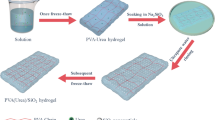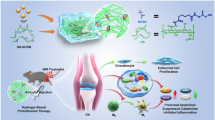Abstract
The aim of this study was to prepare inclusion nanocomplexes of hyaluronic acid-β-cyclodextrin and simvastatin (HA-β-CD/SIM) and evaluate in vitro anti-inflammation effects on lipopolysaccharide (LPS)-activated synoviocytes and chondrogenic differentiation effects on rat adipose-derived stem cells (rADSCs). The β-CD moieties in HA-β-CD could incorporate SIM to form HA-β-CD/SIM nanocomplexes with diameters of 297–350 nm. HA-β-CD/SIM resulted in long-term release of SIM from the nanocomplexes for up to 63 days in a sustained manner. In vitro studies revealed that HA-β-CD/SIM nanocomplexes were able to effectively and dose-dependently suppress the mRNA expression levels of pro-inflammatory markers such as matrix metallopeptidase-3 (MMP-3), MMP-13, cyclooxygenase-2 (COX-2), a disintegrin and metalloproteinase with thrombospondin motifs-5 (ADAMTS-5), interleukin-6 (IL-6), and tumor necrosis factor (TNF-α) in LPS-stimulated synoviocytes. HA-β-CD/SIM-treated rADSCs significantly and dose-dependently enhanced mRNA expressions of aggrecan, collagen type II (COL2A1), and collagen type X (COL10A1), implying that HA-β-CD/SIM greatly induced the chondrogenic differentiation of rADSCs. Conclusively, HA-β-CD/SIM nanocomplexes will be a promising therapeutic material to alleviate inflammation as well as promote chondrogenesis.








Similar content being viewed by others
References
Vangsness CT Jr, Burke WS, Narvy SJ, MacPhee RD, Fedenko AN. Human knee synovial fluid cytokines correlated with grade of knee osteoarthritis—a pilot study. Bull NYU Hosp Jt Dis. 2011;69:122–7.
Benito MJ, Veale DJ, FitzGerald O, van den Berg WB, Bresnihan B. Synovial tissue inflammation in early and late osteoarthritis. Ann Rheum Dis. 2005;64:1263–7.
Goldring MB, Birkhead J, Sandell LJ, Kimura T, Krane SM. Interleukin 1 suppresses expression of cartilage-specific types II and IX collagens and increases types I and III collagens in human chondrocytes. J Clin Invest. 1988;82:2026–37.
Richardson DW, Dodge GR. Effects of interleukin-1beta and tumor necrosis factor-alpha on expression of matrix-related genes by cultured equine articular chondrocytes. Am J Vet Res. 2000;61:624–30.
Kapoor M, Martel-Pelletier J, Lajeunesse D, Pelletier JP, Fahmi H. Role of proinflammatory cytokines in the pathophysiology of osteoarthritis. Nat Rev Rheumatol. 2011;7:33–42.
Rahmati M, Mobasheri A, Mozafari M. Inflammatory mediators in osteoarthritis: a critical review of the state-of-the-art, current prospects, and future challenges. Bone. 2016;85:81–90.
Gupta A, Guyomard V, Zaman MJ, Rehman HU, Myint PK. Systematic review on evidence of the effectiveness of cholesterol-lowering drugs. Adv Ther. 2010;27:348–64.
Buchwald H, Campos CT, Boen JR, Nguyen PA, Williams SE. Disease-free intervals after partial ileal bypass in patients with coronary heart disease and hypercholesterolemia: report from the Program on the Surgical Control of the Hyperlipidemias (POSCH). J Am Coll Cardiol. 1995;26:351–7.
Liao JK, Laufs U. Pleiotropic effects of statins. Annu Rev Pharmacol Toxicol. 2005;45:89–118.
Kimura M, Kurose I, Russell J, Granger DN. Effects of fluvastatin on leukocyte-endothelial cell adhesion in hypercholesterolemic rats. Arterioscler Thromb Vasc Biol. 1997;17:1521–6.
Ito T, Ikeda U, Shimpo M, Ohki R, Takahashi M, Yamamoto K, et al. HMG-CoA reductase inhibitors reduce interleukin-6 synthesis in human vascular smooth muscle cells. Cardiovasc Drugs Ther. 2002;16:121–6.
Ito T, Ikeda U, Yamamoto K, Shimada K. Regulation of interleukin-8 expression by HMG-CoA reductase inhibitors in human vascular smooth muscle cells. Atherosclerosis. 2002;165:51–5.
Bellosta S, Via D, Canavesi M, Pfister P, Fumagalli R, Paoletti R, et al. HMG-CoA reductase inhibitors reduce MMP-9 secretion by macrophages. Arterioscler Thromb Vasc Biol. 1998;18:1671–8.
Luan Z, Chase AJ, Newby AC. Statins inhibit secretion of metalloproteinases-1, -2, -3, and -9 from vascular smooth muscle cells and macrophages. Arterioscler Thromb Vasc Biol. 2003;23:769–75.
Thunyakitpisal PD, Chaisuparat R. Simvastatin, an HMG-CoA reductase inhibitor, reduced the expression of matrix metalloproteinase-9 (Gelatinase B) in osteoblastic cells and HT1080 fibrosarcoma cells. J Pharmacol Sci. 2004;94:403–9.
Zhang H, Lin CY. Simvastatin stimulates chondrogenic phenotype of intervertebral disc cells partially through BMP-2 pathway. Spine (Phila Pa 1976). 2008;33:E525–31.
Han Y, Kim SJ. Simvastatin induces differentiation of rabbit articular chondrocytes via the ERK-1/2 and p38 kinase pathways. Exp Cell Res. 2016;346:198–205.
Ho WY, Yeap SK, Ho CL, Rahim RA, Alitheen NB. Development of multicellular tumor spheroid (MCTS) culture from breast cancer cell and a high throughput screening method using the MTT assay. PLoS One. 2012;7:e44640.
Hrnack SA, Barber FA. Managing the pain of knee osteoarthritis. Phys Sportsmed. 2014;42:63–70.
Brooks PM. The burden of musculoskeletal disease—a global perspective. Clin Rheumatol. 2006;25:778–81.
Wang L, Li LL, Fan YS, Wang H. Host–guest supramolecular nanosystems for cancer diagnostics and therapeutics. Adv Mater. 2013;25:3888–98.
Park JW, Yun YP, Park K, Lee JY, Kim HJ, Kim SE, et al. Ibuprofen-loaded porous microspheres suppressed the progression of monosodium iodoacetate-induced osteoarthritis in a rat model. Colloids Surf B Biointerfaces. 2016;147:265–73.
Basraon SK, Costantine MM, Saade G, Menon R. The effect of simvastatin on infection-induced inflammatory response of human fetal membranes. Am J Reprod Immunol. 2015;74:54–61.
McFarland AJ, Davey AK, Anoopkumar-Dukie S. Statins reduce lipopolysaccharide-induced cytokine and inflammatory mediator release in an in vitro model of microglial-like cells. Mediators Inflamm. 2017;2017:2582745.
Dombrecht EJ, Van Offel JF, Bridts CH, Ebo DG, Seynhaeve V, Schuerwegh AJ, et al. Influence of simvastatin on the production of pro-inflammatory cytokines and nitric oxide by activated human chondrocytes. Clin Exp Rheumatol. 2007;25:534–9.
Heng BC, Cao T, Lee EH. Directing stem cell differentiation into the chondrogenic lineage in vitro. Stem Cells. 2004;22:1152–67.
Ponta H, Sherman L, Herrlich PA. CD44: from adhesion molecules to signalling regulators. Nat Rev Mol Cell Biol. 2003;4:33–45.
Barter MJ, Hui W, Lakey RL, Catterall JB, Cawston TE, Young DA. Lipophilic statins prevent matrix metalloproteinase-mediated cartilage collagen breakdown by inhibiting protein geranylgeranylation. Ann Rheum Dis. 2010;69:2189–98.
Lazzerini PE, Capecchi PL, Nerucci F, Fioravanti A, Chellini F, Piccini M, et al. Simvastatin reduces MMP-3 level in interleukin 1beta stimulated human chondrocyte culture. Ann Rheum Dis. 2004;63:867–9.
Zuk PA, Zhu M, Ashjian P, De Ugarte DA, Huang JI, Mizuno H, et al. Human adipose tissue is a source of multipotent stem cells. Mol Biol Cell. 2002;13:4279–95.
Lin Y, Luo E, Chen X, Liu L, Qiao J, Yan Z, et al. Molecular and cellular characterization during chondrogenic differentiation of adipose tissue-derived stromal cells in vitro and cartilage formation in vivo. J Cell Mol Med. 2005;9:929–39.
Kawakami Y, Tsuda M, Takahashi S, Taniguchi N, Esteban CR, Zemmyo M, et al. Transcriptional coactivator PGC-1alpha regulates chondrogenesis via association with Sox9. Proc Natl Acad Sci U S A. 2005;102:2414–9.
Provot S, Schipani E. Molecular mechanisms of endochondral bone development. Biochem Biophys Res Commun. 2005;328:658–65.
Herlofsen SR, Kuchler AM, Melvik JE, Brinchmann JE. Chondrogenic differentiation of human bone marrow-derived mesenchymal stem cells in self-gelling alginate discs reveals novel chondrogenic signature gene clusters. Tissue Eng Part A. 2011;17:1003–13.
Yu DA, Han J, Kim BS. Stimulation of chondrogenic differentiation of mesenchymal stem cells. Int J Stem Cells. 2012;5:16–22.
Acknowledgements
This study was supported by the grants provided by the Bio and Medical Technology Development Program of NRF funded by the Korean government, MSIP (NRF-2017M3A9F5030273 and NRF-2017M3A9B3063640) and a grant provided by the Korea Health Technology R&D Project, Ministry of Health and Welfare, Republic of Korea (HI15C1665).
Author information
Authors and Affiliations
Corresponding authors
Ethics declarations
Conflict of interest
The authors declare no conflict of interest.
Ethical statement
Animal experimental procedures were approved by the Institutional Animal Care and Use Committee of the Korea University Medical Center (KUIACUC-2014-268 and KUIACUC-2014-5).
Rights and permissions
About this article
Cite this article
Kim, TH., Yun, YP., Shim, KS. et al. In Vitro Anti-Inflammation and Chondrogenic Differentiation Effects of Inclusion Nanocomplexes of Hyaluronic Acid-Beta Cyclodextrin and Simvastatin. Tissue Eng Regen Med 15, 263–274 (2018). https://doi.org/10.1007/s13770-018-0119-9
Received:
Revised:
Accepted:
Published:
Issue Date:
DOI: https://doi.org/10.1007/s13770-018-0119-9




